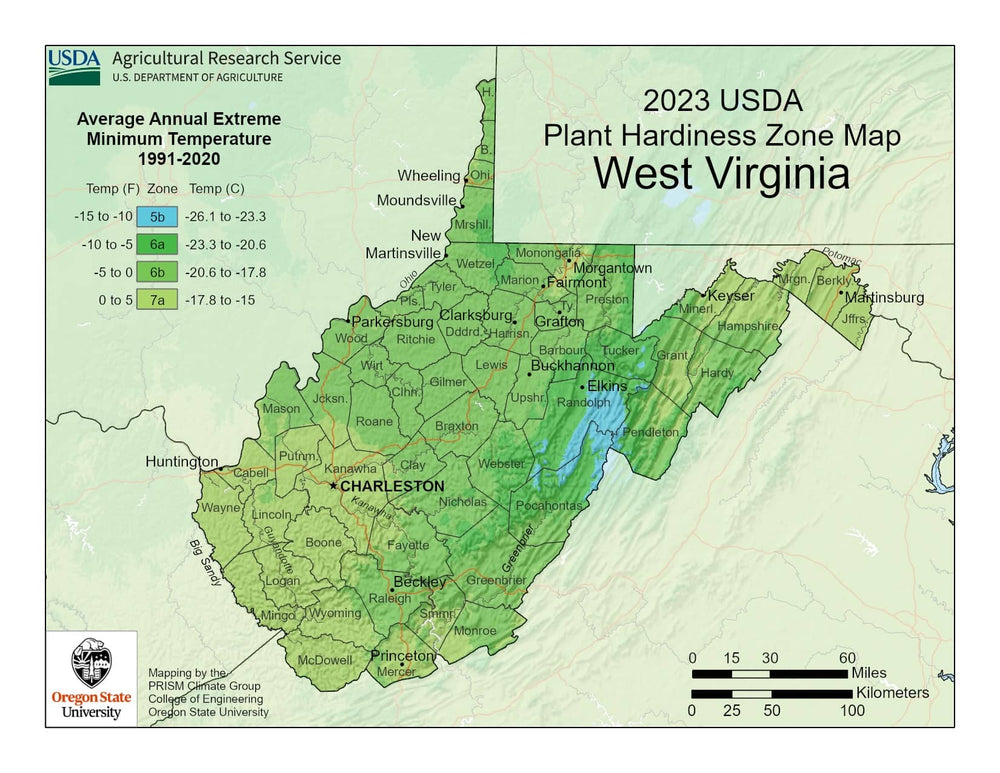Image from USDA
Characteristics of West Virginia’s Planting Region
West Virginia’s climate is generally classified as humid continental, although parts of the state—especially in the lower southern valleys—show characteristics of a humid subtropical zone. The rugged landscape includes the Allegheny Mountains and scenic river valleys, which significantly affect temperature, wind, and rainfall patterns.
West Virginia gardeners can expect:
- Warm, humid summers with average July temperatures between 70°F and 85°F (21°C to 29°C)
- Cold winters, especially in the mountains, with January temperatures often ranging from 15°F to 30°F (-9°C to -1°C)
- Annual precipitation averaging between 38 and 45 inches, with more rainfall in spring and early summer
The growing season varies by region:
- High Elevations (Eastern Highlands): Early June to mid-September
- Central and Northern Regions: Early May to mid-October
- Southern Valleys: Late April to late October

Challenges of Growing in West Virginia
Mountain Microclimates
Elevation changes across short distances create unique challenges for timing and crop selection. Late spring frosts and early autumn chills are common in higher elevations, which can limit the growing season.
Soil Variability
The state’s soils vary widely—from clay-rich valleys to well-drained, rocky hillsides. Gardeners often need to use raised beds or add organic matter to improve soil structure and fertility.
High Humidity & Pests
Humidity levels during summer can lead to fungal diseases like downy mildew and root rot. Common garden pests include squash bugs, slugs, aphids, and cabbage worms, which thrive in moist conditions.

The Benefits of Using a Greenhouse in West Virginia
For gardeners in West Virginia, a greenhouse offers significant advantages, allowing them to manage the state's unpredictable mountain weather and extend the productive months of their garden.
1. Extend Your Growing Season
- Without a Greenhouse: Outdoor gardening typically begins in May and ends by October—sooner in mountain areas.
- With a Greenhouse: Start seedlings as early as February and continue growing into late November or even December. This is especially useful for frost-sensitive crops.
Check your specific growing dates and discover optimal planting timelines for each area of West Virginia.

Customer images of their Greenhouse setup in West Virginia
2. Grow a Wider Variety of Vegetables Without a Greenhouse:
- Without a Greenhouse:
West Virginia outdoor gardens typically succeed with:
|
Tomatoes Peppers Corn Potatoes |
Squash Melons Okra Green beans |
- With a Greenhouse:
You can successfully cultivate a broader range of vegetables, including:
|
Lettuce Spinach Kale Arugula Swiss chard Broccoli Cauliflower Peas |
Brussels sprouts Cabbage Carrots Radishes Beets Turnips Celery Cucumber |
Bell peppers Eggplant Figs Green beans Asparagus Artichokes Kohlrabi Melons |


